
Campaigns (22)
UTS Ku-ring-gai Campus
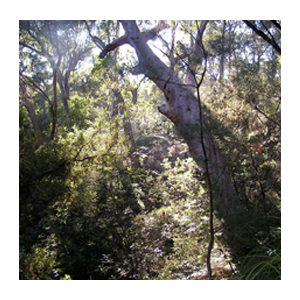 From 1990, STEP was involved with the conservation of urban bushland at the University of Technology Sydney (Ku-ring-gai Campus) at Lindfield. Click here for some history of the site.
From 1990, STEP was involved with the conservation of urban bushland at the University of Technology Sydney (Ku-ring-gai Campus) at Lindfield. Click here for some history of the site.
In 2003, UTS announced its intention to cease using the site as a university and, in conjunction with CRI Australia, to seek rezoning for a residential development on the site of approximately 560 buildings. Ku-ring-gai Council refused the rezoning and the NSW Government took the issue out of Council’s hands. On 14 June 2007, Frank Sartor registered the proposal as significant and pursuant to Schedule 1 of the State Environmental Planning Policy (Major Projects) 2005 and is thus declared as to be a project to which Part 3A of the Environmental Planning and Assessment Act 1979 applies.
STEP's Position
STEP joined a committee, the Community Reference Group (CRG) which immediately expressed very serious concerns on numerous grounds. Although the CRG strongly opposed the proposal, UTS and the Government were able to say that the community had been consulted. The whole procedure, STEP’s position and the issues involved were summarised in STEP Matters (Issue 140, July 2007). Click here for a copy of our submission to the Department of Planning.
The Minister for Planning issued a determination on 11 June 2008. This approval entrenched the preferred project report submitted by consultants for UTS.
We lost a university and some bushland and gained dense housing in a precinct with high fire risk and poor road access. However over 9 hectares (22.6 acres) of bushland was transferred to National Parks. In addition, the community input succeeded in winning some improvements including a reduction in the number of dwellings approved for the site, the retention of a full-sized oval for community use and in retaining heritage buildings on the site.
The land was sold and is now being developed.
Sydney Adventist Hospital Site
 A Win for the Environment but expect Traffic Chaos
A Win for the Environment but expect Traffic Chaos
The Wahroonga Estate Concept Plan was approved by the NSW Minister of Planning on 31 March 2010. This approval brought to an end a saga that began in early-2007 with an initial submission from the developers that would have seen 2000 new residential dwellings, along with expanded schooling, nursing quarters, commercial and retail developments. It would also have meant a massive loss of bushland and many thousands of additional vehicle movements per day, dumped into an area already suffering from chronic peak time traffic congestion.
STEP was actively involved with this process (see below) which led to a significant reduction in the number of proposed residential dwellings and relocation of parts of the school. The development footprint was also scaled back so that the amount of conservation land was increased from 18 ha to 34 ha.
The Wahroonga Estate contains some magnificent bushland including endangered ecological communities such as Blue Gun High Forest and Sydney Turpentine-Ironbark Forest and it has one of the finest examples of vegetation transition from shale to sandstone in northern Sydney. It is currently being well managed and restored by Wahroonga Waterways Landcare. In 2022 plans were submitted for the final stage of the development.
Part 3A of the Environmental Planning and Assessment Act
While STEP never had any problem with the hospital expansion plans, we did object to the significant over-development that the project represented for this particular site. Our concerns intensified when the developer, the Johnson Property Group, a major donor to State Labor, had the Minister call the project in under Part 3A of the Environmental Planning and Assessment Act in December 2007. This effectively removed the development from the decision making of the local community, but of course did nothing to remove the consequences of those decisions from having to be borne into the future by the local community.
Community Reference Group
STEP was appointed to the community reference group which was set up in March 2008 to provide at least the appearance of community consultation on the proposal. The group met five times during the course of the planning stage. STEP and other members of the group worked hard to highlight and identify both the environmental and infrastructural impacts and shortcomings of the various proposals.
This resulted in the matter being referred by the Department of Planning to the Commonwealth Department of the Environment as a ‘controlled action’ in relation to certain critically endangered ecological communities which were on the site.
Positive outcomes
STEP's detailed fact-based submission to the Department of Planning, was strongly supported by the Nature Conservation Council and the National Parks Association. It was also strengthened by an excellent submission from Ku-ring-gai Council. Both submissions challenged many of the inaccurate representations made in the Concept Plan. The developers were also criticised by the NSW Department of Environment and Climate Change regarding the proposed new school, which was, they said, 'poorly sited and planned'. The plans also attracted 160 local individual submissions from the public, of which over 96% were against the development proceeding.
In the end, these submissions resulted in a number of important changes:
- The number of private residential dwellings was reduced from 2000 to 500.
- Certain road links were removed.
- The school hall and oval were relocated.
- A lower scale of housing was decided for Mount Pleasant Avenue.
- The development footprint was scaled back.
- The amount of conservation land was increased from 18 ha to more than 30 ha.
- Half of the site was quarantined from development due to its ‘significant environmental value’ and the presence of endangered ecological communities such as the Sydney Turpentine Ironbark and Blue Gum High Forest. Importantly, this included the removal of the planned residential development on the east side of Fox Valley Road which has one of the finest examples of vegetation transition from shale to sandstone in the northern region of Sydney. The adjoining freeway corridor land to the north-east has a further 2 ha of Blue Gum High Forest/Turpentine-Ironbark Forest, while the lower riparian corridor links to the rare diatreme rainforest vegetation at Browns Field. This is indeed an environmental crown jewel worthy of special protection.
STEP commended both the developer and the SAN for their consideration of the environmental issues involved.
Negative outcomes
- The overall size and scale of the rest of the WER proposal did not alter much.
- The height limit for some buildings was increased to six stories and the retail and commercial expansion plans essentially remained as proposed.
- As the Planning Minister himself said when approving the project, it will become a whole new ‘mini suburb within a suburb’.
- The traffic infrastructure to support the new suburb remains a significant problem area and one without an apparent solution. With only some minor amendments to the original plan, the RTA and the developer believed that the road system was adequate for the proposed development once some upgrades were completed. It was clear that they had not addressed the issues raised in the detailed traffic report submitted by STEP, supported by an independent local traffic consultant. Indeed, the RTA sign-off for the development plan specifically excluded the need to upgrade the Pennant Hills Road/Comenarra Parkway intersection, which had previously been included by the developer's own traffic experts as needing upgrading!
St Ives Showground
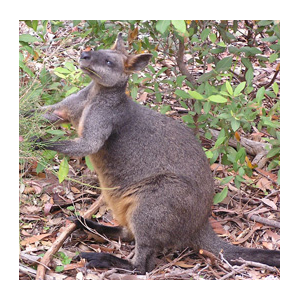 In early 2010, Ku-ring-gai Council placed the draft options for St Ives Showground and precinct lands on public exhibition. STEP made the following points in its submission:
In early 2010, Ku-ring-gai Council placed the draft options for St Ives Showground and precinct lands on public exhibition. STEP made the following points in its submission:
- the need to protect in perpetuity the endangered ecological community known as Duffys Forest
- the removal of the Ku-ring-gai Mini Wheels Training Club (KMWTC) from this environmentally sensitive site
- the retention of the Wildflower Garden in its current location
In June 2010 Ku-ring-gai Council released a report which recommended a departure from the exhibited plan by retaining the KMWTC, despite recognising the widespread environmental damage being done. Indeed on this issue the report specifically noted the need ‘to carry out associated environmental management works to regenerate the Duffys Forest vegetation community’.
On the positive side, the report recommended that Duffys Forest and other existing natural vegetation be protected from encroachment, vehicles, compaction, nutrients, weeds and rubbish. Noting again, the exception of ‘the KMWTC area, which has been damaged over a long period of time. A separate plan will be devised to guide use in the KMWTC area.’
On 26 May 2015, Council adopted the draft St Ives Showground and Precinct Lands Plan of Management (dPoM).
In May 2017 Council commissioned a report on developing the tourism potential of the municipality. The report focused on a plan to redevelop the St Ives precinct to achieve a ‘wow factor’ to attract visitors, benefit residents and help grow the local visitor economy.
In 2021 a draft plan of management was released for St Ives Showground and Precinct Lands. Many community groups put in submissions prior to the deadline. However the papers for the council meeting that was to consider the draft PoM were published before the closing date. The report had obviously been written by council staff some days before. None of the submissions from the community groups were considered in the report. STEP and other groups protested about this treatment. Public consultation was a sham.
Roads
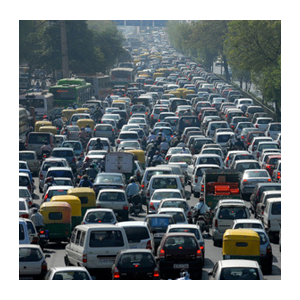 There is inherent conflict between the needs of the human population and the natural environment. We all live in houses on land that was once host to part of a natural ecosystem and we all travel on roads and railways that criss-cross the natural world and so compromise it. There are many more such examples.
There is inherent conflict between the needs of the human population and the natural environment. We all live in houses on land that was once host to part of a natural ecosystem and we all travel on roads and railways that criss-cross the natural world and so compromise it. There are many more such examples.
The issue at hand is not so much that we have such impact, humans have rights too, it is more that there are so many of us that our scale and rate of destruction is such that we have seen, and are facing more, widespread environmental degradation, animal and plant extinctions and other inexcusable consequences.
It is for these reasons that STEP has strong views on human population numbers and on the way that we interact with the remaining natural environment. Here we are talking about the part that freeway standard roads play in the overall problem.
Our planners have always made the basic and inexcusable mistake of building roads to solve existing congestion problems without any regard to the additional congestion those roads will cause. As John Norquist, the former mayor of Milwaukee and transport expert, said at the City of the Future conference in Brisbane at the University of Queensland in November 2010, 'building freeways in cities is like loosening your belt to deal with obesity'. We couldn’t have said it better.
We loosened our belt with the widening of the M2 tollway in 2011. Improved travel times will be nullified by demographic feedback as people take advantage of the improved road to travel more often, to travel closer to peak times and to live further away from their work. Congestion will quickly return and create the inevitable demands for more roads.
STEP has participated in the debate about expressway construction for 30 years. We were very involved in the campaign that resulted in the proposed expressway through the length of the Lane Cove Valley bushland being abandoned and have participated by responding to all proposals such as the original M2 and the proposed F3 to M2 and M7 link.
The debate is more than the environmental and social harm done by, or the practical futility of some road projects. It is about the sort of city that we want Sydney to be, about whether we really want to have 9 million people in another 50 years and 18 million in 100, about why we don’t build an integrated transport network with emphasis on rail and public transport, about why we don’t take demographic feedback into account in our planning and, crucially, why none of our politicians are prepared to address the longer term planning issues and why they cannot see that there cannot be infinite growth in a finite world.
We have assembled below our key road publications and submissions, along with other relevant references and shall add to them as time goes by.
F3 to M2 Link Proposal
In 2002 the RTA commissioned, on behalf of the Australian Government, a study to identify a route connecting the Western Sydney Orbital (M2/M7) to the F3, in Sydney's north, to relieve pressure on Pennant Hills Road and Pacific Highway.
The F3 to Sydney Orbital Link Study, carried out by consultants Sinclair Knight Merz (SKM) examined three corridors (Types A, B and C) and ultimately recommended that the preferred route follow the Type A Purple Option, linking the F3 to the M2 via an 8 km road tunnel beneath Pennant Hills Road, and this was duly accepted and endorsed in July 2004 by the Australian Government.
Significant objection and vocal opposition to the study's recommendations led to the 2007 Review of the F3 to M7 Corridor Selection by the Hon Mahla Pearlman AO, former Chief Judge of the NSW Land and Environment Court.
The Pearlman Report of September 2007 recognised changes in land use and transport flows since the study, however these reinforced the selection of the preferred route. The report also confirmed that assumptions and data used in the study were valid, and overall recommended that:
- the preferred route (the Type A Purple Option) 'be progressed to the next stages of investigation including: detailed concept design, economic and financial impact assessment'; and
- a Type C corridor be planned.
2008 saw many hysterical stories and editorials in local newspapers complaining about hold-ups on the F3 due to serious accidents and bushfires.
Ever since the original SKM study, local groups and identities – supported by the Pearlman Report (as an option after the tunnel link construction), the NRMA and a Sydney Morning Herald editorial in January 2008 – are calling for the construction of another freeway link from the Central Coast to the M7, crossing the Hawkesbury River west of the existing F3 crossing.
STEP's Position
STEP has always been aware of the danger to urban bushland posed by the old Lane Cove Valley freeway corridor. In recent years, we have continued to comment, preparing submissions for SKM's study and the Pearlman Report, as there are still vested interests lobbying for a surface route through the Lane Cove Valley and also because transport planning impacts on our present and future environment.
STEP is opposed to any F3 to Sydney Orbital link as will ultimately:
- increase traffic on the local road network in the long term
- encourage unsustainable car-dependent development in the region and particularly on the coast
- cause changes to travel behaviour that will increase air pollution in the Sydney Basin
- have the potential to destroy local bushland
We insist and recommend that nothing should happen until there is an integrated transport plan for NSW, and by this we mean that there must be an end to the continuous patching up of an ailing public transport and freight transport system, that factors such as population growth and impending peak oil should be assessed and a strategy developed to take us through the next 100 years.
- Lane Cove Valley Freeway Position Paper (1990)
- F3-M2 Proposed Link Position Paper (2002)
- Comment on the F3 to Sydney Orbital Link Study (2003, STEP Matters, Issue 119, p3)
- Submission on the F3 to Sydney Orbital Proposal (2003)
- Comment on the Outcome of the F3 to Sydney Orbital Study (2004, STEP Matters, Issue 124, p2)
- Submission to the Pearlman Review of the F3 to M7 Corridor Selection (2007)
- History of the Lane Cove Valley Freeway Proposals (2007, STEP Matters, Issue 142, p5)
- Update on the Issues Surrounding the F3 to Sydney Orbital Link (2010, STEP Matters, Issue 154, p6–7)
- Comment on the Proposed M2 Upgrade (2010, STEP Matters, Issue 155, p4–5)
Population
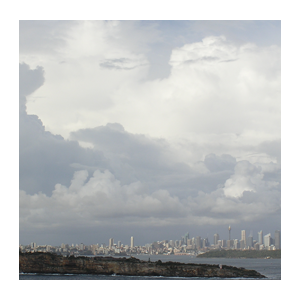 Position Paper on Population (2011)
Position Paper on Population (2011)- Australia’s Population hits 25 million but who is Cheering? (NMI Matters 199)
- Rapid Population Growth – Witches Hats Claim another Casualty (NMI Matters 183)
- Submission on the Issues Paper: A Sustainable Population Strategy for Australia (February 2011)
- Integenerational Report 2015: Why should Australia become so Big so Fast? (NMI Matters 180)
Many, perhaps most, media commentators and some environmentalists seem to believe that the population debate is all a dog-whistling exercise orchestrated by the bigoted and xenophobic. While there are of course some of those people around, that is far from STEP’s position.
The population debate is not about boat people, not about race, not about culture, not about religion, not about refugees in general and not about how many children one should have. It's a bigger issue. There can of course be rational discussion on all of those matters but they are peripheral to population.
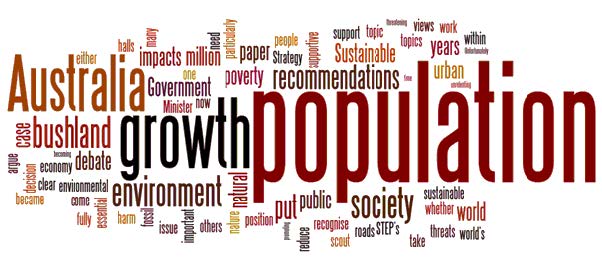
We start from a world view where we see population heading to over 9 billion with much of it climbing rapidly out of poverty towards our level of consumption so that finite resources are being used up at an ever-increasing rate and huge natural areas being alienated to accommodate people. We see increasing rates of extinctions and the virtual impossibility of reducing the greenhouse effect in time to avert disaster. Jared Diamond's book, Collapse: How Societies Choose to Fail or Succeed informs us of the human race's dismal track record. We see the possibility, indeed the probability, of famine, war and massive dislocations.
At home we see that Australia's fragile environment is already highly stressed. We see cities like Sydney growing exponentially and using up farms and bushland while placing ever-increasing demands on scarce resources such as water. We see our mines sending ever-increasing supplies of coal that will add to world pollution and we see places such as the Barrier Reef degrading.
We also see our leaders, almost without exception, promoting never-ending GDP and population growth. We see the effective lobbying of churches and that of the BCA and its powerful members for exponentially expanding markets and consumption. And we see almost none of our leaders prepared to admit that there could be a problem looming or to discuss the issue.
We see that at our current rate of growth of about 2% per annum, Australia will have some 90 million people in 75 years and Sydney 18 million. With the lower rates of growth some are talking about it will take a little longer but the result will be the same.
So what is our vision?
We would like our leaders at all levels to openly discuss the issue. We want our leaders to appreciate that there cannot be infinite growth in a finite world and we would like them to plan to do something about it. It must be appreciated that there are many wealthy countries without increasing populations that are doing well and that per capita wealth, rather than GDP, is the real measure of financial well-being.
We have heard many politicians at the state and local level say that they cannot do anything about the problem because it's all the fault of the Federal Government. We see that as the ultimate cop-out. State and local government leaders have an obligation to engage the Federal Government on all issues affecting their domain. They engage with them on health, education, the Murray-Darling and other such issues. Would it not be negligent to not engage them also on population?
Bushland Tracks and Trails
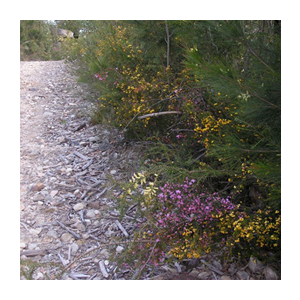 STEP is of the view that there are many positive aspects to a system of well-planned and well-maintained tracks and trails in urban bushland. When combined with good signage they open up the wonders of the bush and promote conservation education. Tracks and trails should be part of a system which protects the bushland, should be appropriately managed and should enhance the enjoyment of bushland by locals and visitors.
STEP is of the view that there are many positive aspects to a system of well-planned and well-maintained tracks and trails in urban bushland. When combined with good signage they open up the wonders of the bush and promote conservation education. Tracks and trails should be part of a system which protects the bushland, should be appropriately managed and should enhance the enjoyment of bushland by locals and visitors.
In August 2010, we published a position paper, encouraging the construction of tracks and trails for recreational and management purposes in areas that are degraded and severely degraded. We think that space should be provided for creative track building to encourage team skills, creativity and physical skills of young people. This needs to be associated with a remedial plan and no loss of neighbourhood amenity. Track and trail construction is not recommended in:
- areas with threatened populations, ecological communities or species
- areas which contain aboriginal, cultural or geological heritage
- riparian areas
- core bushland (bushland that has not been substantially modified)
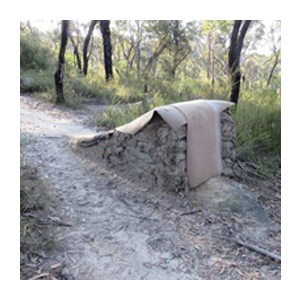 Bushwalking is generally an acceptable activity on all tracks and trails, except those specifically designed for some other purpose such as bike riding. Cycling is an appropriate activity if confined to authorised sections of management trails and to separate authorised cycling tracks in degraded areas. Recreational motorised vehicles and horses are generally not acceptable on any track, with the exception of existing dedicated horse trails.
Bushwalking is generally an acceptable activity on all tracks and trails, except those specifically designed for some other purpose such as bike riding. Cycling is an appropriate activity if confined to authorised sections of management trails and to separate authorised cycling tracks in degraded areas. Recreational motorised vehicles and horses are generally not acceptable on any track, with the exception of existing dedicated horse trails.
Blue Gum High Forest
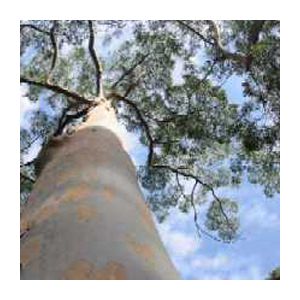 In 2007 the Blue Gum High Forest Group, a coalition of concerned groups, won their long-running campaign to protect the Blue Gum High Forest in St Ives. They:
In 2007 the Blue Gum High Forest Group, a coalition of concerned groups, won their long-running campaign to protect the Blue Gum High Forest in St Ives. They:
- succeeded in having the Blue Gum High Forest ecological community listed as critically endangered under Commonwealth legislation
- campaigned successfully to have both 100 and 102 Rosedale Road purchased
- successfully nominated the Blue Gum High Forest for listing on the NSW Heritage Register
Blue Gum High Forest Discovery Kits are available to schools and other interested parties from Friends of Lane Cove National Park.
Short History
1938–1990
One owner, house since demolished and forest regenerating.
1990
Purchased for $1.8m; 9-lot subdivision refused by Ku-ring-gai Council.
1997
Gazettal of Blue Gum High Forest as an endangered ecological community.
2000
Lot 12 (102 Rosedale Road) and Lot 13 (100 Rosedale Road) sold for $2.2m.
2002
Land and Environment Court rejected a 4-lot subdivision on Lot 12 on the grounds of its inability to provide a sufficient asset protection zone (from bushfire hazard) and also its impact on the endangered Blue Gum High Forest community.
2004
Development application was submitted to Ku-ring-gai Council for a dwelling on 100 Rosedale Road.
2005
100–102 Rosedale Road was advertised for sale.
2005
Ku-ring-gai Council unanimously agreed to allocate part-funding for the purchase of 100–102 Rosedale Road.
2005
Commonwealth Minister for Environment and Heritage listed the Blue Gum High Forest and the Turpentine Ironbark Forest in the Sydney Basin as critically endangered.
2005
100 Rosedale Road was bought by the NSW Transport Infrastructure Development Corporation as an offset to compensate for 0.33 ha of Blue Gum High Forest destroyed as a result of upgrading Hornsby Railway Station and the property was transferred to the Department of Environment and Conservation.
2006
Blue Gum High Forest St Ives was selected as a Threatened Species Demonstration Site. This endangered ecological community was the first of 11 sites within the Sydney Metropolitan Catchment Management Area chosen to showcase best practice management to ensure the long-term viability of threatened species, populations and/or ecological communities.
2007
NSW Scientific Committee determined that the Blue Gum High Forest ecological community be listed as critically endangered, recognising the increased level of threat since it was listed as endangered in 1977 under the NSW Threatened Species Conservation Act.
2007
A development application was submitted for a large single dwelling on 102 Rosedale Road. The application was rejected by Ku-ring-gai Council.
2007
102 Rosedale Road was purchased by Ku-ring-gai Council, assisted by $350,000 from the National Reserve System and over $72,000 in public donations.
Campaigns
Submissions to Government
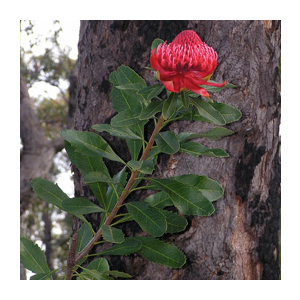 STEP is continually responding to relevant issues. These may be comments on plans of management for natural areas, the questioning of inappropriate development proposals, taking land managers to task for neglect or inappropriate management actions, and a myriad of other matters that seem to occur far too often. Click here for our submissions to government.
STEP is continually responding to relevant issues. These may be comments on plans of management for natural areas, the questioning of inappropriate development proposals, taking land managers to task for neglect or inappropriate management actions, and a myriad of other matters that seem to occur far too often. Click here for our submissions to government.
Blue Gum High Forest
In 2007 the Blue Gum High Forest Group, a coalition of concerned groups, won their long-running campaign to protect the Blue Gum High Forest in St Ives read more
Bushland Tracks and Trails
STEP is of the view that there are many positive aspects to a system of well-planned and well-maintained tracks and trails in urban bushland read more
Population
Many media commentators and some environmentalists seem to believe that the population debate is all a dog-whistling exercise orchestrated by the bigoted and xenophobic. While there are of course some of those people around that is far from STEP’s position read more
Powerful Owls
STEP is hosting information on protecting powerful owls in Sydney on behalf of the Powerful Owl Coalition read more
Roads
STEP has participated in the debate about expressway construction for 35 years. We were very involved in the campaign that resulted in the proposed expressway through the length of the Lane Cove Valley bushland being abandoned and have participated by responding to all proposals such as the original M2 and the proposed F3 to M2 and M7 link read more
Spanish moss
STEP is concerned about the potential impact of Spanish moss on our bushland read more
St Ives Showground
In early 2010 Ku-ring-gai Council placed the draft options for St Ives Showground and precinct lands on public exhibition read more
Stringybark Ridge
Stringybark Ridge is part of the Berowra Valley National Park. The main parties involved seemed then to be in agreement that this is how it should remain. However in March 2015 NPWS issued a new draft PoM which proposed a spectacular reversal of their own previous policy read more
Sydney Adventist Hospital Site
The Wahroonga Estate Concept Plan was approved by the NSW Minister of Planning on 31 March 2010. This approval brought to an end a saga that began in early-2007 read more
UTS (Ku-ring-gai Campus)
For the last 25 years, STEP has been involved with the future and conservation of urban bushland at the University of Technology Sydney campus at Lindfield read more
